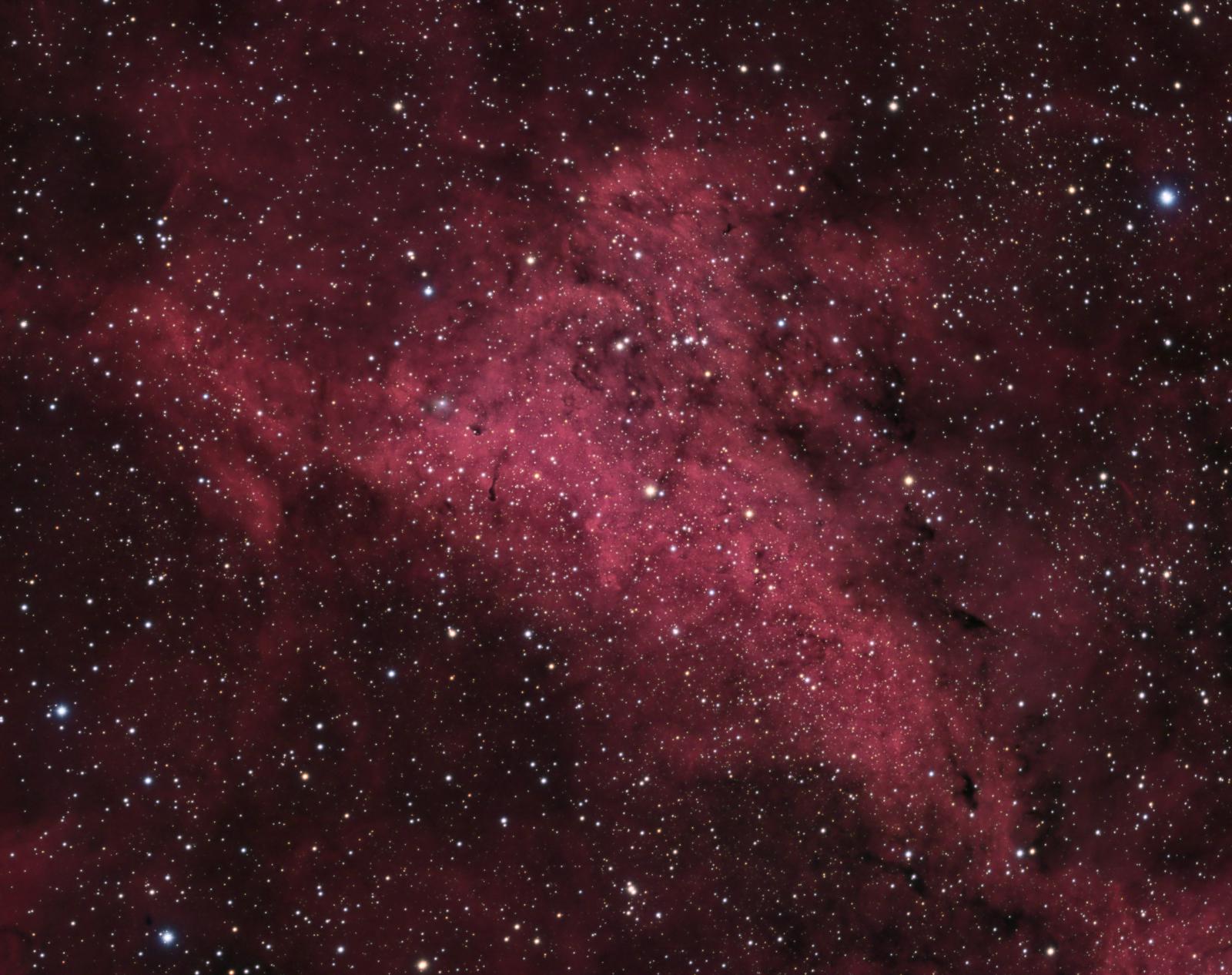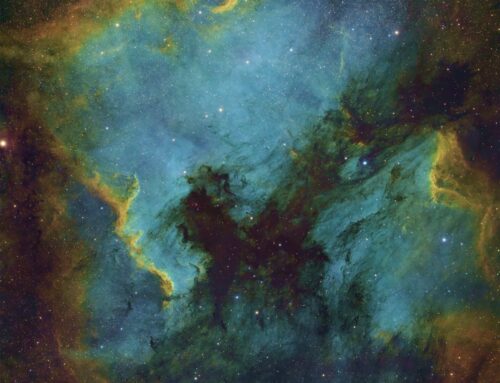Northwest of Sadr (LBN 251)
 Click image for full size version
Click image for full size version
November 2, 2018
LBN 251 lies just northwest of Sadr, in Cygnus, and appears to be part of the same large cloud of hydrogen that makes up nearby IC1318. To my eye, this object looks like a pouncing cat. What do you see?
There is a small blue reflection nebula to the upper left of centre. I didn’t find a catalogue number for it.
Tekkies:
Sky-Watcher Esprit 150 f/7 refractor, QHY 16200-A camera, Optolong Ha, L, R, G and B filters, Paramount MX. Acquisition with TheSkyX unguided. Focused with FocusMax 4. Automation with CCDCommander. All pre-processing and processing in PixInsight. Acquired from my SkyShed in Guelph. No Moon for L, moderate moonlight for Ha and RGB, average to excellent transparency and fair to average seeing. Data acquired October 13 – 29, 2018.
16x5m L, 17x5m R, 14x5m G, 18x5m B, and 21x10m Ha (Total = 8hr55m).
Data Reduction and Cleanup
The BatchPreProcessing script was used to perform calibration, cosmetic correction and registration of all frames. ImageIntegration was used to make the L, Ha, R, G and B masters. DynamicCrop was used to crop all the masters identically. DynamicBackgroundExtraction was applied to each master.
RGB:
Creation and cleanup: The R, G and B were combined to make an RGB image which was processed with PhotometricColorCalibration.
Linear Noise Reduction: MultiscaleLinearTransform was used to reduce noise in the RGB image. Layer settings for threshold and strength: Layer 1: 3.0 0.8 Layer 2: 2.5, 0.7 Layer 3: 2., 0.6 Layer 4: 1.0, 0.2 Layer 5: 0.5, 0.1.
Stretching: HistogramTransformation was applied to make a pleasing, bright image. Curve was applied to boost contrast and saturation.
Luminance:
Creation and cleanup of SynthL: The L, R, G and B masters were combined using ImageIntegration (average, additive with scaling, noise evaluation, iterative K-sigma / biweight midvariance, no pixel rejection).
Deconvolution: A star mask was made to use as a Local Deringing Support image. A copy of the image was stretched to use as a range mask. Deconvolution was applied (50 iterations, regularized Richardson-Lucy, external PSF made using DynamicPSF tool with about 30 stars).
Linear Noise Reduction: MultiscaleLinearTransform was used to reduce noise in the background areas, using an internal mask to protect bright structures. Layer settings for threshold and strength: Layer 1: 3.0 0.9 Layer 2: 2.0, 0.75 Layer 3: 1.0, 0.6 Layer 4: 0.5, 0.2.
Stretching: HistogramTransformation was applied to make a pleasing, bright image.
H-alpha:
Deconvolution: A star mask was made to use as a Local Deringing Support image. A copy of the image was stretched to use as a range mask. Deconvolution was applied (80 iterations, regularized Richardson-Lucy, external PSF made using DynamicPSF tool with about 20 stars).
Linear Noise Reduction: MultiscaleLinearTransform was used to reduce noise in the background areas of the Ha image. Layer settings for threshold and strength: Layer 1: 3.0 0.9 Layer 2: 2.0, 0.75 Layer 3: 1.0, 0.6 Layer 4: 0.5, 0.2.
Stretching: HistogramTransformation was applied to the Ha to make a pleasing, bright image.
Contrast Enhancement: HDRMultiscaleTransform was applied to the Ha twice, at scales of 6 and 4. A mask was used to select bright nebula and protect stars, faint nebula and background sky.
Combining SynthL, RGB and Ha:
SynthLRGB: The SynthL was applied to the RGB image using LRGBCombine.
SynthLHaRGB: PixelMath was used to add Ha to the RGB, using the following expressions for the R, G and B channels:
R: max($T[0], 1.3*Ha)
G: $T[1]
B: iif($T[0]<Ha, $T[2] + 0.1*Ha, $T[2])
Additional Processing
Nonlinear Noise Reduction: TGVDenoise was used in L*a*b* mode to reduce noise in the background areas.
Sharpening: MultiscaleLinearTransform was used to sharpen Layers 2 and 3 (strengths of 0.1 and 0.2 respectively. A mask was used to protect dim nebulosity, background and stars.
Contrast Enhancement: LocalHistogramEqualization was applied with a scale of 50 (max contrast 1.5, strength 0.47, 1 iteration), followed by a scale of 150 max contrast 1.5, strength 0.25, 1 iteration).
Final Steps: Star sizes were reduced using MorphologicalTransformation’s Morphological Selection tool with a blurred star mask that selected large and medium sized stars (selection 0.14, strength 0.2, 3 iterations). Background, nebula and star brightness, contrast and saturation were adjusted in several iterations using Curves with masks as required. The DarkStructureEnhance script was applied with 8 layers and a strength of 0.25.
Image scale is about 1.15 arcsec per pixel for this camera/telescope combination.






Leave A Comment